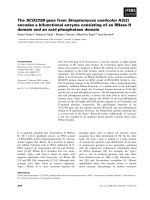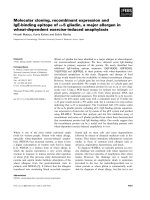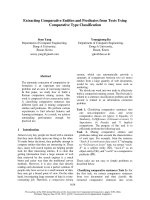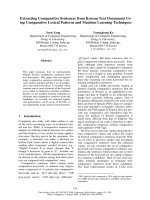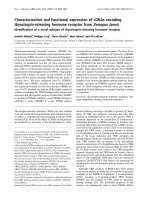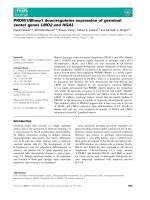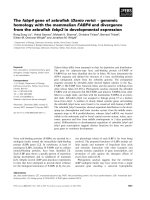Báo cáo khoa học: "Extracting Regulatory Gene Expression Networks from PubMed" pptx
Bạn đang xem bản rút gọn của tài liệu. Xem và tải ngay bản đầy đủ của tài liệu tại đây (384.33 KB, 8 trang )
Extracting Regulatory Gene Expression Networks from PubMed
Jasmin
ˇ
Sari
´
c
EML Research gGmbH
Heidelberg, Germany
Lars J. Jensen
EMBL
Heidelberg, Germany
Rossitza Ouzounova
EMBL
Heidelberg, Germany
Isabel Rojas
EML Research gGmbH
Heidelberg, Germany
Peer Bork
EMBL
Heidelberg, Germany
Abstract
We present an approach using syntacto-
semantic rules for the extraction of rela-
tional information from biomedical ab-
stracts. The results show that by over-
coming the hurdle of technical termi-
nology, high precision results can be
achieved. From abstracts related to
baker’s yeast, we manage to extract a
regulatory network comprised of 441
pairwise relations from 58,664 abstracts
with an accuracy of 83–90%. Toachieve
this, we made use of a resource of
gene/protein names considerably larger
than those used in most other biology re-
lated information extraction approaches.
This list of names was included in the
lexicon of our retrained part-of-speech
tagger for use on molecular biology ab-
stracts. For the domain in question an
accuracy of 93.6–97.7% was attained on
POS-tags. The method is easily adapted
to other organisms than yeast, allowing
us to extract many more biologically rel-
evant relations.
1 Introduction and related work
A massive amount of information is buried in
scientific publications (more than 500,000 pub-
lications per year). Therefore, the need for in-
formation extraction (IE) and text mining in the
life sciences is drastically increasing. Most of
the ongoing work is being dedicated to deal with
PubMed
1
abstracts. The technical terminology of
biomedicine presents the main challenge of apply-
ing IE to such a corpus (Hobbs, 2003).
The goal of our work is to extract from bio-
logical abstracts which proteins are responsible
for regulating the expression (i.e. transcription or
translation) of which genes. This means to extract
a specific type of pairwise relations between bio-
logical entities. This differs from the BioCreAtIvE
competition tasks
2
that aimed at classifying en-
tities (gene products) into classes based on Gene
Ontology (Ashburner et al., 2000).
A task closely related to ours, which has re-
ceived some attention over the past five years,
is the extraction of protein–protein interactions
from abstracts. This problem has mainly been ad-
dressed by statistical “bag of words” approaches
(Marcotte et al., 2001), with the notable exception
of Blaschke et al. (1999). All of the approaches
differ significantly from ours by only attempting
to extract the type of interaction and the partici-
pating proteins, disregarding agens and patiens.
Most NLP based studies tend to have been fo-
cused on extraction of events involving one par-
ticular verb, e.g. bind (Thomas et al., 2000) or in-
hibit (Pustejovsky et al., 2002). From a biological
point of view, there are two problems with such
approaches: 1) the meaning of the extracted events
1
PubMed is a bibliographic database covering life sci-
ences with a focus on biomedicine, comprising around 12 ×
10
6
articles, roughly half of them including abstract (http:
//www.ncbi.nlm.nih.gov/PubMed/).
2
Critical Assessment of Information Extraction sys-
tems in Biology, />biocreative/
will depend strongly on the selectional restrictions
and 2) the same meaning can be expressed using
a number of different verbs. In contrast and alike
(Friedman et al., 2001), we instead set out to han-
dle only one specific biological problem and, in
return, extract the related events with their whole
range of syntactic variations.
The variety in the biological terminology used
to describe regulation of gene expression presents
a major hurdle to an IE approach; in many cases
the information is buried to such an extent that
even a human reader is unable to extract it unless
having a scientific background in biology. In this
paper we will show that by overcoming the termi-
nological barrier, high precision extraction of en-
tity relations can be achieved within the field of
molecular biology.
2 The biological task and our approach
To extract relations, one should first recognize
the named entities involved. This is particu-
larly difficult in molecular biology where many
forms of variation frequently occur. Synonymy
is very common due to lack of standardization of
gene names; BYP1, CIF1, FDP1, GGS1, GLC6,
TPS1, TSS1, and YBR126C are all synonyms for
the same gene/protein. Additionally, these names
are subject to orthographic variation originating
from differences in capitalization and hyphenation
as well as syntactic variation of multiword terms
(e.g. riboflavin synthetase beta chain = beta chain
of riboflavin synthetase). Moreover, many names
are homonyms since a gene and its gene product
are usually named identically, causing cross-over
of terms between semantic classes. Finally, para-
grammatical variations are more frequent in life
science publications than in common English due
to the large number of publications by non-native
speakers (Netzel et al., 2003).
Extracting that a protein regulates the expres-
sion of a gene is a challenging problem as this fact
can be expressed in a variety of ways—possibly
mentioning neither the biological process (expres-
sion) nor any of the two biological entities (genes
and proteins). Figure 1 shows a simplified ontol-
ogy providing an overview of the biological en-
tities involved in gene expression, their ontologi-
cal relationships, and how they can interact with
Gene
Transcript
Gene
product
Stable
RNA
Promoter
Binding
site
Upstream
activating
sequence
Upstream
repressing
sequence
mRNA
Protein
Transcription
regulator
Transcription
activator
Transcription
repressor
is a
part of
produces
binds to
Figure 1: A simplified ontology for transcrip-
tion regulation. The background color used for
each term signifies its semantic role in relations:
regulator (white), target (black), or either (gray).
one another. An ontology is a great help when
writing extraction rules, as it immediately sug-
gests a large number of relevant relations to be
extracted. Examples include “promoter contains
upstream activating sequence” and “transcription
regulator binds to promoter”, both of which fol-
low from indirect relationships via binding site.
It is often not known whether the regulation
takes place at the level of gene transcription or
translation or by an indirect mechanism. For this
reason, and for simplicity, we decided against try-
ing to extract how the regulation of expression
takes place. We do, however, strictly require that
the extracted relations provide information about a
protein (the regulator, R) regulating the expression
of a gene (the target, X), for which reason three re-
quirements must be fulfilled:
1. It must be ascertained that the sentence men-
tions gene expression. “The protein R acti-
vates X” fails this requirement, as R might
instead activate X post-translationally. Thus,
whether the event should be extracted or not
depends on the type of the accusative object
X (e.g. gene or gene product). Without a head
noun specifying the type, X remains ambigu-
ous, leaving the whole relation underspeci-
fied, for which reason it should not be ex-
tracted. It should be noted that two thirds of
the gene/protein names mentioned in our cor-
pus are ambiguous for this reason.
2. The identity of the regulator (R) must be
known. “The X promoter activates X ex-
pression” fails this requirement, as it is not
known which transcription factor activates
the expression when binding to the X pro-
moter. Linguistically this implies that noun
chunks of certain semantic types should be
disallowed as agens.
3. The identity of the target (X) must be known.
“The transcription factor R activates R de-
pendent expression” fails this requirement, as
it is not know which gene’s expression is de-
pendent on R. The semantic types allowed for
patiens should thus also be restricted.
The two last requirements are important to avoid
extraction from non-informative sentences that—
despite them containing no information—occur
quite frequently in scientific abstracts. The color-
ing of the entities in Figure 1 helps discern which
relations are meaningful and which are not.
The ability to genetically modify an organism in
experiments brings about further complication to
IE: biological texts often mention what takes place
when an organism is artificially modified in a par-
ticular way. In some cases such modification can
reverse part of the meaning of the verb: from the
sentence “Deletion of R increased X expression”
one can conclude that R represses expression of
X. The key point is to identify that “deletion of
R” implies that the sentence describes an exper-
iment in which R has been removed, but that R
would normally be present and that the biological
impact of R is thus the opposite of what the verb
increased alone would suggest. In other cases the
verb will lose part of its meaning: “Mutation of
R increased X expression” implies that R regu-
lates expression X, but we cannot infer whether
R is an activator or a repressor. In this case mu-
tation is dealt in a manner similar to deletion in
the previous example. Finally, there are those re-
lations that should be completely avoided as they
exist only because they have been artificially in-
troduced through genetic engineering. In our ex-
traction method we address all three cases.
We have opted for a rule based approach (im-
plemented as finite state automata) to extract the
relations for two reasons. The first is, that a rule
based approach allows us to directly ensure that
the three requirements stated above are fulfilled
for the extracted relations. This is desired to attain
high accuracy on the extracted relations, which is
what matters to the biologist. Hence, we focus in
our evaluation on the semantic correctness of our
method rather than on its grammatical correctness.
As long as grammatical errors do not result in se-
mantic errors, we do not consider it an error. Con-
versely, even a grammatically correct extraction is
considered an error if it is semantically wrong.
Our second reason for choosing a rule based ap-
proach is that our approach is theory-driven and
highly interdisciplinary, involving computational
linguists, bioinformaticians, and biologists. The
rule based approach allows us to benefit more
from the interplay of scientists with different back-
grounds, as known biological constraints can be
explicitly incorporated in the extraction rules.
3 Methods
Table 1 shows an overview of the architecture of
our IE system. It is organized in levels such that
the output of one level is the input of the next one.
The following sections describe each level in de-
tail.
3.1 The corpus
The PubMed resource was downloaded on Jan-
uary 19, 2004. 58,664 abstracts related to the
yeast Saccharomyces cerevisiae were extracted
by looking for occurrences of the terms “Sac-
charomyces cerevisiae”, “S. cerevisiae”, “Baker’s
yeast”, “Brewer’s yeast”, and “Budding yeast” in
the title/abstract or as head of a MeSH term
3
.
These abstracts were filtered to obtain the 15,777
that mention at least two names (see section 3.4)
and subsequently divided into a training and an
evaluation set of 9137 and 6640 abstracts respec-
tively.
3
Medical Subject Headings (MeSH) is a controlled vo-
cabulary for manually annoting PubMed articles.
Level Component
L0 Tokenization and multiwords
Word and sentence boundaries are de-
tected and multiwords are recognized
and recomposed to one token.
L1 POS-Tagging
A part-of-speech tag is assigned to each
word (or multiword) of the tokenized
corpus.
L2 Semantic labeling
A manually built taxonomy is used to
assign semantic labels to tokens. The
taxonomy consists of gene names, cue
words relevant for entity recognition,
and classes of verbs for relation extrac-
tion.
L3 Named entity chunking
Based on the POS-tags and the se-
mantic labels, a cascaded chunk gram-
mar recognizes noun chunks relevant
for the gene transcription domain, e.g.
[
nxgene
The GAL4 gene ].
L4 Relation chunking
Relations between entities are recog-
nized, e.g. The expression of the cy-
tochrome genes CYC1 and CYC7 is
controlled by HAP1.
L5 Output and visualization
Information is gathered from the recog-
nised patterns and transformed into
pre-defined records. From the example
in L4 we extract that HAP1 regulates
the expression of CYC1 and CYC7.
Table 1: Overview over the extraction architecture
3.2 Tokenization and multiword detection
The process of tokenization consists of two steps
(Grefenstette and Tapanainen, 1994): segmenta-
tion of the input text into a sequence of tokens
and the detection of sentential boundaries. We
use the tokenizer developed by Helmut Schmid at
IMS (University of Stuttgart) because it combines
a high accuracy (99.56% on the Brown corpus)
with unsupervised learning (i.e. no manually la-
belled data is needed) (Schmid, 2000).
The determination of token boundaries in tech-
nical or scientific texts is one of the main chal-
lenges within information extraction or retrieval.
On the one hand, technical terms contain spe-
cial characters such as brackets, colons, hyphens,
slashes, etc. On the other hand, they often ap-
pear as multiword expressions which makes it
hard to detect the left and right boundaries of
the terms. Although a lot of work has been in-
vested in the detection of technical terms within
biology related texts (see Nenadi´c et al. (2003) or
Yamamoto et al. (2003) for representative results)
this task is not yet solved to a satisfying extent. As
we are interested in very special terms and high
precision results we opted for multiword detection
based on semi-automatical acquisition of multi-
words (see sections 3.4 and 3.5).
3.3 Part-of-speech tagging
To improve the accuracy of POS-tagging on
PubMed abstracts, TreeTagger (Schmid, 1994)
was retrained on the GENIA 3.0 corpus (Kim et
al., 2003). Furthermore, we expanded the POS-
tagger lexicon with entries relevant for our appli-
cation such as gene names (see section 3.4) and
multiwords (see section 3.5). As tag set we use
the UPenn tag set (Santorini, 1991) plus some mi-
nor extensions for distinguishing auxiliary verbs.
The GENIA 3.0 corpus consists of PubMed ab-
stracts and has 466,179 manually annotated to-
kens. For our application we made two changes
in the annotation. The first one concerns seem-
ingly undecideable cases like in/or annotated as
in|cc. These were split into three tokens: in, /,
and or each annotated with its own tag. This was
done because TreeTagger is not able to annotate
two POS-tags for one token. The second set of
changes was to adapt the tag set so that vb is
used for derivates of to be, vh for derivates of
to have, and vv for all other verbs.
3.4 Recognizing gene/protein names
To be able to recognize gene/protein names as
such, and to associate them with the appropri-
ate database identifiers, a list of synonymous
names and identifiers in six eukaryotic model
organisms was compiled from several sources
(available from l.
de/synonyms/). For S. cerevisiae specifically,
51,640 uniquely resolvable names and identi-
fiers were obtained from Saccharomyces Genome
Database (SGD) and SWISS-PROT (Dwight et al.,
2002; Boeckmann et al., 2003).
Before matching these names against the POS-
tagged corpus, the list of names was expanded
to include different orthographic variants of each
name. Firstly, the names were allowed to have
various combinations of uppercase and lowercase
letters: all uppercase, all lowercase, first letter up-
percase, and (for multiword names) first letter of
each word uppercase. In each of these versions,
we allowed whitespace to be replaced by hyphen,
and hyphen to be removed or replaced by whites-
pace. In addition, from each gene name a possible
protein name was generated by appending the let-
ter p. The resulting list containing all orthographic
variations comprises 516,799 entries.
The orthographically expanded name list was
fed into the multiword detection, the POS-tagger
lexicon, and was subsequently matched against the
POS-tagged corpus to retag gene/protein names as
such (nnpg). By accepting only matches to words
tagged as common nouns (nn), the problem of
homonymy was reduced since e.g. the name MAP
can occur as a verb as well.
3.5 Semantic tagging
In addition to the recognition of the gene and pro-
tein names, we recognize several other terms and
annotate them with semantic tags. This set of se-
mantically relevant terms mainly consists of nouns
and verbs, as well as some few prepositions like
from, or adjectives like dependent. The first main
set of terms consists of nouns, which are classified
as follows:
• Relevant concepts in our ontology: gene,
protein, promoter, binding site, transcription
factor, etc. (153 entries).
• Relational nouns, like nouns of activation
(e.g. derepression and positive regulation),
nouns of repression (e.g. suppression and
negative regulation), nouns of regulation (e.g.
affect and control) (69 entries).
• Triggering experimental (artificial) contexts:
mutation, deletion, fusion, defect, vector,
plasmids, etc. (11 entries).
• Enzymes: gyrase, kinase, etc. (569 entries).
• Organism names extracted from the NCBI
taxonomy of organisms (Wheeler et al.,
2004) (20,746 entries).
The second set of terms contains 50 verbs and their
inflections. They were classified according to their
relevance in gene transcription. These verbs are
crucial for the extraction of relations between en-
tities:
• Verbs of activation e.g. enhance, increase, in-
duce, and positively regulate.
• Verbs of repression e.g. block, decrease,
downregulate, and down regulate.
• Verbs of regulation e.g. affect and control.
• Other selected verbs like code (or encode)
and contain where given their own tags.
Each of the terms consisting of more than one
word was utilized for multiword recognition.
We also have have two additional classes of
words to prevent false positive extractions. The
first contains words of negation, like not, cannot,
etc. The other contains nouns that are to be distin-
guished from other common nouns to avoid them
being allowed within named entitities, e.g. allele
and diploid.
3.6 Extraction of named entities
In the preceding steps we classified relevant nouns
according to semantic criteria. This allows us to
chunk noun phrases generalizing over both POS-
tags and semantic tags. Syntacto-semantic chunk-
ing was performed to recognize named entities us-
ing cascades of finite state rules implemented as a
CASS grammar (Abney, 1996). As an example we
recognize gene noun phrases:
[
nx
gene
[
dt
the]
[
nnpg
CYC1]
[
gene
gene]
[
in
in]
[
yeast
Saccharomyces cerevisiae]]
Other syntactic variants, as for example “the glu-
cokinase gene GLK1” are recognized too. Simi-
larly, we detect at this early level noun chunks de-
noting other biological entities such as proteins,
activators, repressors, transcription factors etc.
Subsequently, we recognize more complex
noun chunks on the basis of the simpler ones,
e.g. promoters, upstream activating/repressing se-
quences (UAS/URS), binding sites. At this point
it becomes important to distinguish between agens
and patiens forms of certain entities. Since a bind-
ing site is part of a target gene, it can be referred to
either by the name of this gene or by the name of
the regulator protein that binds to it. It is thus nec-
essary to discriminate between “binding site of”
and “binding site for”.
As already mentioned, we have annotated a
class of nouns that trigger experimental context.
On the basis of these we identify noun chunks
mentioning, as for example deletion, mutation, or
overexpression of genes. At a fairly late stage we
recognize events that can occur as arguments for
verbs like “expression of”.
3.7 Extraction of relations between entities
This step of processing concerns the recognition
of three types of relations between the recognized
named entities: up-regulation, down-regulation,
and (underspecified) regulation of expression. We
combine syntactic properties (subcategorization
restrictions) and semantic properties (selectional
restrictions) of the relevant verbs to map them to
one of the three relation types.
The following shows a reduced bracketed struc-
ture consting of three parts, a promoter chunk, a
verbal complex chunk, and a UAS chunk in pa-
tiens:
[
nx
prom
the ATR1 promoter region]
[
contain
contains]
[
nx uas pt
[
dt−a
a] [
bs
binding site] [
for
for]
[
nx activator
the GCN4 activator protein]].
From this we extract that the GCN4 protein acti-
vates the expression of the ATR1 gene. We iden-
tify passive constructs too e.g. “RNR1 expression
is reduced by CLN1 or CLN2 overexpression”. In
this case we extract two pairwise relations, namely
that both CLN1 and CLN2 down-regulate the ex-
pression of the RNR1 gene. We also identify nom-
inalized relations as exemplified by “the binding
of GCN4 protein to the SER1 promoter in vitro”.
4 Results
Using our relation extraction rules, we were able
to extract 422 relation chunks from our com-
plete corpus. Since one entity chunk can men-
tion several different named entities, these corre-
sponded to a total of 597 extracted pairwise rela-
tions. However, as several relation chunks may
mention the same pairwise relations, this reduces
to 441 unique pairwise relations comprised of 126
up-regulations, 90 down-regulations, and 225 reg-
ulations of unknown direction.
Figure 2 displays these 441 relations as a regu-
latory network in which the nodes represent genes
or proteins and the arcs are expression regulation
relations. Known transcription factors according
to the Saccharomyces Genome Database (SGD)
(Dwight et al., 2002) are denoted by black nodes.
From a biological point of view, it is reassuring
that these tend to correspond to proteins serving
as regulators in our relations.
Figure 2: The extracted network of gene regu-
lation The extracted relations are shown as a di-
rected graph, in which each node corresponds to a
gene or protein and each arc represents a pairwise
relation. The arcs point from the regulator to the
target and the type of regulation is specified by the
type of arrow head. Known transcription factors
are highlighted as black nodes.
4.1 Evaluation of relation extraction
To evaluate the accuracy of the extracted relation,
we manually inspected all relations extracted from
the evaluation corpus using the TIGERSearch vi-
sualization tool (Lezius, 2002).
The accuracy of the relations was evaluated at
the semantic rather than the grammatical level. We
thus carried out the evaluation in such a way that
relations were counted as correct if they extracted
the correct biological conclusion, even if the anal-
ysis of the sentence is not as to be desired from
a linguistic point of view. Conversely, a relation
was counted as an error if the biological conclu-
sion was wrong.
75 of the 90 relation chunks (83%) extracted
from the evaluation corpus were entirely correct,
meaning that the relation corresponded to expres-
sion regulation, the regulator (R) and the regulatee
(X) were correctly identified, and the direction of
regulation (up or down) was correct if extracted.
Further 6 relation chunks extracted the wrong di-
rection of regulation but were otherwise correct;
our accuracy increases to 90% if allowing for this
minor type of error. Approximately half of the er-
rors made by our method stem from overlooked
genetic modifications—although mentioned in the
sentence, the extracted relation is not biologically
relevant.
4.2 Entity recognition
For the sake of consistency, we have also evaluated
our ability to correctly identify named entities at
the level of semantic rather than grammatical cor-
rectness. Manual inspection of 500 named enti-
ties from the evaluation corpus revealed 14 errors,
which corresponds to an estimated accuracy of just
over 97%. Surprisingly, many of these errors were
commited when recognizing proteins, for which
our accuracy was only 95%. Phrases such as
“telomerase associated protein” (which got con-
fused with “telomerase protein” itself) were re-
sponsible for about half of these errors.
Among the 153 entities involved in relations no
errors were detected, which is fewer than expected
from our estimated accuracy on entity recogni-
tion (99% confidence according to hypergeomet-
ric test). This suggests that the templates used for
relation extraction are unlikely to match those sen-
tence constructs on which the entity recognition
goes wrong. False identification of named entities
are thus unlikely to have an impact on the accuracy
of relation extraction.
4.3 POS-tagging and tokenization
We compared the POS-tagging performance of
two parameter files on 55,166 tokens from the GE-
NIA corpus that were not used for retraining. Us-
ing the retrained tagger, 93.6% of the tokens were
correctly tagged, 4.1% carried questionable tags
(e.g. confusing proper nouns for common nouns),
and 2.3% were clear tagging errors. This com-
pares favourably to the 85.7% correct, 8.5% ques-
tionable tags, and 5.8% errors obtained when us-
ing the Standard English parameter file. Retrain-
ing thus reduced the error rate more than two-fold.
Of 198 sentences evaluated, the correct sen-
tence boundary was detected in all cases. In ad-
dition, three abbreviations incorrectly resulted in
sentence marker, corresponding to an overall pre-
cision of 98.5%.
5 Conclusions
We have developed a method that allows us to ex-
tract information on regulation of gene expression
from biomedical abstracts. This is a highly rel-
evant biological problem, since much is known
about it although this knowledge has yet to be col-
lected in a database. Also, knowledge on how
gene expression is regulated is crucial for inter-
preting the enormous amounts of gene expression
data produced by high-throughput methods like
spotted microarrays and GeneChips.
Although we developed and evaluated our
method on abstracts related to baker’s yeast only,
we have successfully applied the method to other
organisms including humans (to be published else-
where). The main adaptation required was to re-
place the list of synonymous gene/protein names
to reflect the change of organism. Furthermore,
we also intend to reuse the recognition of named
entities to extract other, specific types of interac-
tions between biological entities.
Acknowledgments
The authors wish to thank Sean Hooper for help
with Figure 2. Jasmin
ˇ
Sari´c is funded by the Klaus
Tschira Foundation gGmbH, Heidelberg (http:
//www.kts.villa-bosch.de). Lars Juhl
Jensen is funded by the Bundesministerium f¨ur
Forschung und Bildung, BMBF-01-GG-9817.
References
S. Abney. 1996. Partial parsing via finite-state cas-
cades. In Proceedings of the ESSLLI ’96 Robust
Parsing Workshop, pages 8–15, Prague, Czech Re-
public.
M. Ashburner, C. A. Ball, J. A. Blake, D. Botstein,
H. Butler, J. M. Cherry, A. P. Davis, K. Dolinski,
S. S. Dwight, J. T. Eppig, M. A. Harris, D. P. Hill,
L. Issel-Tarver, A. Kasarskis, S. Lewis, J. C. Matese,
J. E. Richardson, M. Ringwald, G. M. Rubin, and
G. Sherlock. 2000. Gene Ontology: tool for the
unification of biology. Nature Genetics, 25:25–29.
C. Blaschke, M. A. Andrade, C. Ouzounis, and A. Va-
lencia. 1999. Automatic extraction of biological in-
formation from scientific text: protein–protein inter-
actions. In Proc., Intelligent Systems for Molecular
Biology, volume 7, pages 60–67, Menlo Park, CA.
AAAI Press.
B. Boeckmann, A. Bairoch, R. Apweiler, M. C. Blat-
ter, A. Estreicher, E. Gasteiger, M. J. Martin, K Mi-
choud, C. O’Donovan, I. Phan, S. Pilbout, and
M. Schneider. 2003. The SWISS-PROT pro-
tein knowledgebase and its supplement TrEMBL in
2003. Nucleic Acids Res., 31:365–370.
S. S. Dwight, M. A. Harris, K. Dolinski, C. A. Ball,
G. Binkley, K. R. Christie, D. G. Fisk, L. Issel-
Tarver, M. Schroeder, G. Sherlock, A. Sethuraman,
S. Weng, D. Botstein, and J. M. Cherry. 2002. Sac-
charomyces Genome Database (SGD) provides sec-
ondary gene annotation using the Gene Ontology
(GO). Nucleic Acids Res., 30:69–72.
C. Friedman, P. Kra, H. Yu, M. Krauthammer, and
A. Rzhetsky. 2001. GENIES: a natural-language
processing system for the extraction of molecular
pathways from journal articles. Bioinformatics, 17
Suppl. 1:S74–S82.
G. Grefenstette and P. Tapanainen. 1994. What is a
word, what is a sentence? problems of tokenization.
In The 3rd International Conference on Computa-
tional Lexicography, pages 79–87.
J. R. Hobbs. 2003. Information extraction from
biomedical text. J. Biomedical Informatics.
J D. Kim, T. Ohta, Y. Tateisi, and J. Tsujii. 2003. GE-
NIA corpus—a semantically annotated corpus for
bio-textmining. Bioinformatics, 19 suppl. 1:i180–
i182.
W. Lezius. 2002. TIGERSearch—ein Suchwerkzeug
f¨ur Baumbanken. In S. Busemann, editor, Proceed-
ings der 6. Konferenz zur Verarbeitung natrlicher
Sprache (KONVENS 2002), Saarbr¨ucken, Germany.
E. M. Marcotte, I. Xenarios, and D. Eisenberg. 2001.
Mining literature for protein–protein interactions.
Bioinformatics, 17:359–363.
G. Nenadi´c, S. Rice, I. Spasi´c, S. Ananiadou, and
B. Stapley. 2003. Selecting text features for gene
name classification: from documents to terms. In
S. Ananiadou and J. Tsujii, editors, Proceedings of
the ACL 2003 Workshop on Natural Language Pro-
cessing in Biomedicine, pages 121–128.
R. Netzel, Perez-Iratxeta C., P. Bork, and M. A. An-
drade. 2003. The way we write. EMBO Rep.,
4:446–451.
J. Pustejovsky, J. Casta˜no, J. Zhang, M. Kotecki, and
B. Cochran. 2002. Robust relational parsing over
biomedical literature: Extracting inhibit relations.
In Proceedings of the Seventh Pacific Symposium on
Biocomputing, pages 362–373, Hawaii. World Sci-
entific.
B. Santorini. 1991. Part-of-speech tagging guidelines
for the penn treebank project. Technical report, Uni-
versity of Pennsylvania.
H. Schmid. 1994. Probabilistic part-of-speech tagging
using decision trees. In International Conference on
New Methods in Language Processing, Manchester,
UK.
H. Schmid. 2000. Unsupervised learning of period
disambiguation for tokenisation. Technical report,
Institut fr Maschinelle Sprachverarbeitung, Univer-
sity of Stuttgart.
J. Thomas, D. Milward, C. Ouzounis, S. Pulman, and
M. Carroll. 2000. Automatic extraction of protein
interactions from scientific abstracts. In Proceed-
ings of the Fifth Pacific Symposium on Biocomput-
ing, pages 707–709, Hawaii. World Scientific.
D. L. Wheeler, D. M. Church, R. Edgar, S. Feder-
hen, W. Helmberg, Madden T. L., Pontius J.
U., Schuler G. D., Schriml L. M., E. Sequeira,
T. O. Suzek, T. A. Tatusova, and L. Wagner.
2004. Database resources of the national center for
biotechnology information: update. Nucleic Acids
Res., 32:D35–40.
K. Yamamoto, T. Kudo, A. Konagaya, and Y. Mat-
sumoto. 2003. Protein name tagging for biomedi-
cal annotation in text. In S. Ananiadou and J. Tsujii,
editors, Proceedings of the ACL 2003 Workshop on
Natural LanguageProcessing in Biomedicine, pages
65–72.

